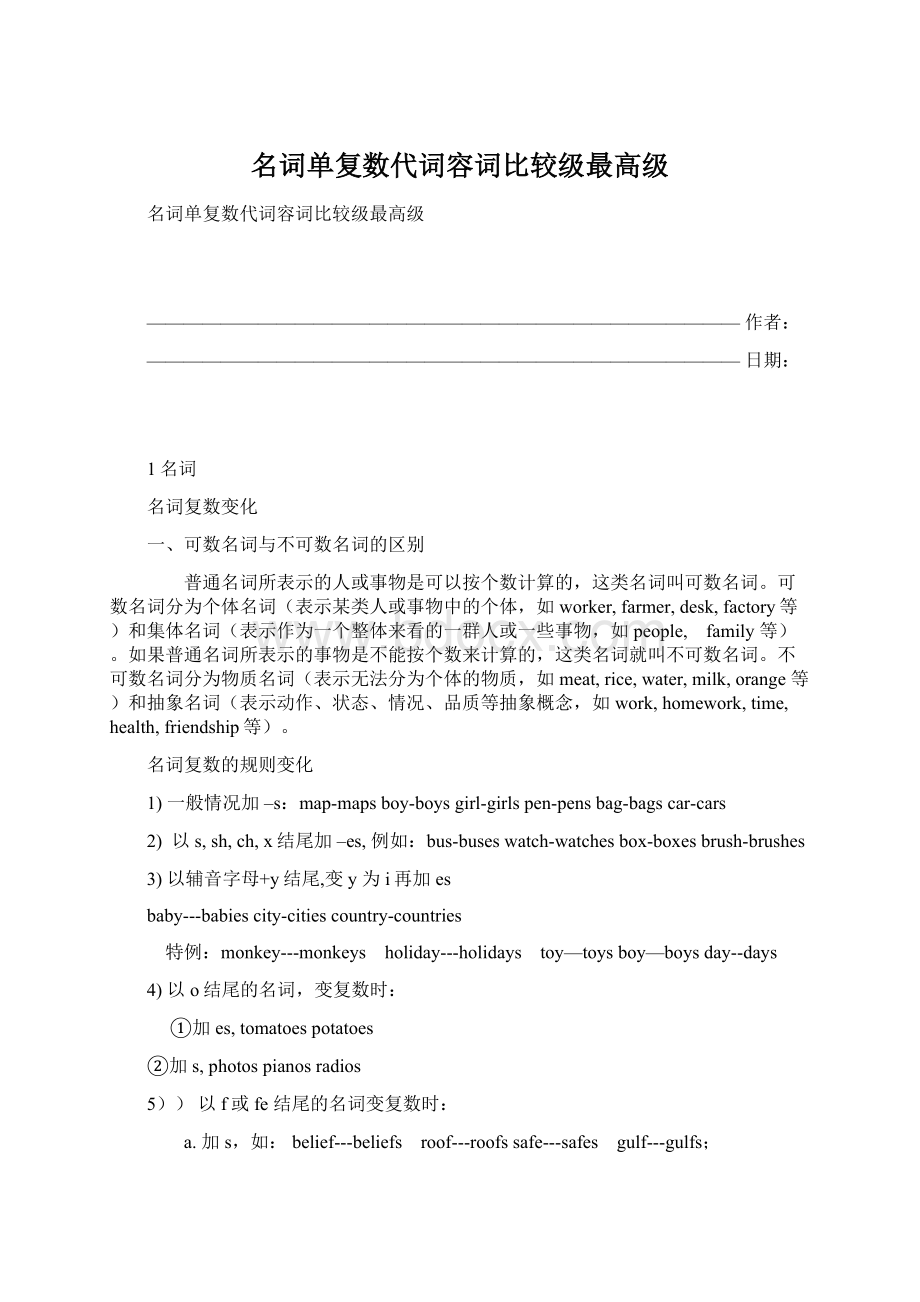名词单复数代词容词比较级最高级.docx
《名词单复数代词容词比较级最高级.docx》由会员分享,可在线阅读,更多相关《名词单复数代词容词比较级最高级.docx(13页珍藏版)》请在冰豆网上搜索。

名词单复数代词容词比较级最高级
名词单复数代词容词比较级最高级
————————————————————————————————作者:
————————————————————————————————日期:
1名词
名词复数变化
一、可数名词与不可数名词的区别
普通名词所表示的人或事物是可以按个数计算的,这类名词叫可数名词。
可数名词分为个体名词(表示某类人或事物中的个体,如worker,farmer,desk,factory等)和集体名词(表示作为一个整体来看的一群人或一些事物,如people, family等)。
如果普通名词所表示的事物是不能按个数来计算的,这类名词就叫不可数名词。
不可数名词分为物质名词(表示无法分为个体的物质,如meat,rice,water,milk,orange等)和抽象名词(表示动作、状态、情况、品质等抽象概念,如work,homework,time,health,friendship等)。
名词复数的规则变化
1)一般情况加–s:
map-mapsboy-boysgirl-girlspen-pensbag-bagscar-cars
2)以s,sh,ch,x结尾加–es,例如:
bus-buseswatch-watchesbox-boxesbrush-brushes
3)以辅音字母+y结尾,变y为i再加es
baby---babiescity-citiescountry-countries
特例:
monkey---monkeys holiday---holidays toy—toysboy—boysday--days
4)以o结尾的名词,变复数时:
①加es,tomatoespotatoes
②加s,photospianosradios
5))以f或fe结尾的名词变复数时:
a.加s,如:
belief---beliefs roof---roofssafe---safes gulf---gulfs;
b.去f或e加ves,如:
half---halves knife---knives leaf---leaves wolf---wolves
wife---wives life---lives thief---thieves;
特例:
handkerchief:
handkerchiefs/handkerchieves。
名词复数的不规则变化
1)child---children foot---feet tooth---teethman---menwoman---womenmouse---mice
2)单复数同形,如deer,sheep,fish,Chinese(中国人),Japanese(日本人)people
不可数名词
不可数名词是指不能以数目来计算,不可以分成个体的概念、状态、品质、感情或表示物质材料的东西;它一般没有复数形式,只有单数形式,它的前面不能用不定冠词a/an。
常用不可数名词
具体名词:
baggage行李bread面包beer啤酒 cloth布coffee咖啡cream奶油dust尘土 furniture家具 glass玻璃gold黄金 hair头发 ice冰 jam果酱juice饮料 luggage行李 money金钱oil油 paper纸 soap肥皂 steak牛排stone石头 tea茶water水 weather天气wind风 wine葡萄酒wood木头advice忠告/主意
抽象名词:
work工作beauty美丽,漂亮damage损害death死亡experience经验help帮助hope希望horror恐惧 information消息/信息knowledge知识courage勇气news新闻
一、请写出下列词的复数形式,没有复数形式的请划出/
city______zoo______country_____tooth____mouse____
boy___________broom___________cartree_____horse_____bus___________
fox_____branch_____baby_____family_____country_____
radio_____photo_____piano_____knife_____leaf_____
life_____thief______man_____woman______child___
footthis_____________watch___________ people
day____________ book__________ dress____________ sheep___________tea_____________
box___________ strawberry_________ yo-yo___________peach_________sandwich_________paper_________ juice__________water____________ milk___________ rice__________ CD ox___________deer____________fish_______________diary____________
二、单项选择
()1.The__inouryardareverybeautiful.
A.cloth B.water C.flowers
()2.TomisoneoftheChinese_____inourschool.
A.boy B.boys C.boies
()3.Acathasfour____,doesn'tit?
A.foots B.feet C.feets
()4.Therearethree____andfive_____intheroom.
A.American,JapaneseBAmericans,Japanese
C.American,Janpaneses
()5.Canyouseenine____inthepicture?
A.fish B.book C.horse
()6.The_____hastwo______.
A.boy;watch B.boy;watches C.boys;watch
()7.The_____areflyingbacktotheircountry.
A.Germany B.Germanys C.Germans
()8.Thegirlbrushesher_____everydaybeforehegoestobed.
A.tooths B.teeth C.teeths
()9.Isawmany_____inthestreet.
ApeoplesB.peopleC.people’s
()10.Thegreensweaterishis_________.
A.brotherB.brothersC.brother’s
三、选择填空
()1.Theycomefromdifferent______
A.countryB.countriesC.acountryD.countrys
()2.Howmany______doyouseeinthepicture?
A.tomatosB.tomatoesC.tomatoD.thetomato
()3.Theyare______.
A.womanteachersB.womenteachersC.womenteacherD.womanteacher
()4.Wouldyoulike_______,please?
A.twoglassofwaterB.twoglassesofwater
C.twoglassofwatersD.twoglassesofwaters
()6.Therearesome______inthese_______.
A.knifespencil-boxesB.knivespencils-box
C.knivespencil-boxD.knivespencils-boxes
()7.______like______byair.
A.Greens,travellingB.TheGreen,traveling
C.TheGreens,travelD.TheGreens,traveling
()8.Iwonderwhy______areinterestedinactionfilms(武打片).
A.thepeopleB.peopleC.peoplesD.thepeoples
()9.Thereisno______intheplate.
A.applesB.orangesC.riceD.eggs
()10.Myunclehasthree_______.
A.childB.childsC.childrenD.childrens
四.填入所给名词的正确形式
1.Ihavetwo____________(knife)
2.Therearemany___________here.(box)
3.Therearemany___________ontheroad.(bus)
4.Afew___________aredrawingonthewall.(boy)
5.The______________areplayingfootballnow.(child)
6.Pleasetaketwo_______________forme.(photo)
7.Ilikethered________________.(tomato)
8.Wouldyoupleasecleanyour_____________now?
(tooth)
9.Doyouwantsome___________?
(milk)
10.Thereareten___________________inourschool.(womanteacher)
五、名词可数不可数“六注意”
1、可数名词前可用具体的数词来表示具体的数量。
如:
twoapples,fourbooks等。
不可数名词前通常用"单位词+of"来表示数量。
如:
apieceofpaper,threepiecesofpaper等。
2、可数名词作主语时,谓语动词的单复数与主语的单复数保持一致。
如:
Thispictureisverybeautiful.这幅画很美。
不可数名词作主语时,谓语动词要用单数形式,但是不可数名词前有复数"单位词"时,谓语动词要用复数形式。
如:
Therearetwocupsofteaonthetable.桌上有两杯茶。
3、对可数名词前的修饰语提问用howmany;对不可数名词前的修饰语提问用howmuch。
如:
Howmanyapplesarethereinthebox?
盒子里有多少个苹果?
Howmuchteaisthereinthecup?
杯里有多少茶水?
注意:
对不可数名词前的"单位词"的修饰语提问时,疑问词用howmany。
如:
Howmanypiecesofbreadarethereontheplate?
盘子里有多少片面包?
量词
apieceof一块一张一片
aloafof一个
abarof一条
abottleof一瓶
apoundof一磅
atinof一听
aquarterof四分之一
2代词
请在此处画上代词表:
1.人称代词:
主格、宾格(动前主格、动后宾,be前主格介后宾)
2.物主代词:
形代、名代
3.反身代词:
。
。
。
自己
4.指示代词:
单数(this/that)和复数(these/those)
5.疑问代词:
what,who,whose,whom,which,when。
(疑问副词when,where,how,why)
6.不定代词some(something,somebody,someone),any(anything,anybody,anyone),no(nothing,nobody,noone),every(everything,everybody,everyone,),all,each,both,much,many,(a)little,(a)few,other(s),another,none,one,either,neither等。
一般来讲,修饰不定代词的词要置于其后。
形容词性物主代词只能作定语,后面要接名词。
而名词性物主代词在句中作主语、宾语或表语,它后面再不接名词。
它们的关系为:
名词性物主代词=形容词性物主代词+名词。
Ⅰ.单项选择(选自各地中考题)
()1.ImetKateonwayhomeyesterday.(北京海淀区)
A.myB.meC.hisD.him
()2.Thisisruler.(北京西城区)
A.myB.mineC.ID.me
()3.A:
pencil-boxisthis,Patrick?
B:
It’s.(上海)
A.Whose;mineB.Who’s;mineC.Whose;myD.Who’s;my
()4.Kateandhersisterwentonholidaywithaclassmateof.(黑龙江)
A.herB.hersC.theirD.theirs
()5.—Isthisdictionaryor?
—It’smine.(内蒙古)
A.your;hersB.yours;herC.your;herD.yours;hers
()6.Thepenis.Shewrotenamewithit.(甘肃)
A.hers;her;herselfB.her;hers;her
C.her;hers;herselfD.her;herself;hers
()7.CanIborrowpencil?
isbroken.(河北)
A.you;MyB.your;MeC.your;MineD.your;My
()8.Thesearecups.areoverthere.(河南)
A.our;YoursB.yours;MineC.his;OurD.their;Your
()9.schoolbagismuchbetterthan.(山西)
A.Her;meB.Hers;myC.Hers;mineD.Her;mine
()10.—Oh,thereissomeoneintheroom.
—mustbemymother.(安徽)
A.ThereB.SheC.ThisD.It
()11.—Whichofthesetwosweaterswillyoutake?
—I’lltake.Theylooknearlythesame,andIjustneedone.(江西)
A.bothB.eitherC.noneD.all
()12.—Whichofyourparentsisadoctor?
—are.(天津)
A.AnyB.EitherC.BothD.Neither
()13.Hehastwobasketballs.Oneisnew,isold.(北京海淀区)
A.theotherB.otherC.theothersD.others
()14.Hehastwosisters.Oneisadoctor,isateacher.(内蒙古)
A.anotherB.theotherC.otherD.others
()15.Ihavetwosons,butofthemliveswithme.(河北)
A.allB.bothC.neitherD.few
()16.Ihaveboughtanewwatchbecausemyolddoesn’twork.(重庆)
A.itB.oneC.thatD.this
()17.—CanyouspeakRussian?
—Yes,butonly.(厦门)
A.littleB.alittleC.fewD.afew
()18.—Whatwouldyouliketohave,teaormilk?
—.I’dliketohaveaglassofwater.(杭州)
A.EachB.NeitherC.EitherD.Both
()19.MycarwasbrokenandIdidn’tknowtodo.(杭州)
A.whatB.whichC.whenD.how
()20.—Ishere?
—No.JackandTomhavegonetothelibrary.(湖北黄冈)
A.anybodyB.nobodyC.everybodyD.all
【综合能力训练】
Ⅱ.按括号中提示意思完成下列句子。
1.Theyare(我的)flowers.Pleasegive(它们)to(我).
2.Isthismap(你的)?
No,it’s(他的).Thatoneis(我的).
3.Icanhear(一些,什么),butIcan’tsee(一些,什么).
4.Hesaysto(自己),“Ican’tdoitby(自己)”.
5.(都)ofusarestudents,(都)ofthetwinsareworkers.
3形容词和副词的比较级和最高级
一、形容词、副词的比较级和最高级的构成规则
1.一般单音节词和少数以-er,-ow结尾的双音节词,比较级在后面加-er,最高级在后面加-est;
(1)单音节词
如:
small→smaller→smallestshort→shorter→shortest
tall→taller→tallestgreat→greater→greatest
(2)双音节词
如:
clever→cleverer→cleverestnarrow→narrower→narrowest
2.以不发音e结尾的单音节词,比较在原级后加-r,最高级在原级后加-st;
如:
large→larger→largestnice→nicer→nicestable→abler→ablest
3.在重读闭音节(即:
辅音+元音+辅音)中,先双写末尾的辅音字母,比较级加-er,最高级加-est;
如:
big→bigger→biggesthot→hotter→hottestfat→fatter→fattest
4.以“辅音字母+y”结尾的双音节词,把y改为i,比较级加-er,最高级加-est;
如:
easy→easier→easiestheavy→heavier→heaviest
busy→busier→busiesthappy→happier→happiest
5.其他双音节词和多音节词,比较级在前面加more,最高级在前面加most;
如:
beautiful→morebeautiful→mostbeautiful
different→moredifferent→mostdifferent
easily→moreeasily→mosteasily
注意:
(1)形容词最高级前通常必须用定冠词the,副词最高级前可不用。
例句:
TheSaharaisthebiggestdesertintheworld.
(2)形容词most前面没有the,不表示最高级的含义,只表示"非常"。
Itisamostimportantproblem.
=Itisaveryimportantproblem.
6.有少数形容词、副词的比较级和最高级是不规则的,必须熟记。
如:
good→better→bestwell→better→best
bad→worse→worstill→worse→worst
old→older/elder→oldest/eldest
many/much→more→mostlittle→less→least
far→further/farther→furthest/farthest
二、形容词、副词的比较级和最高级的用法
1.“A+be+形容词比较级+than+B”意思为“A比B更……”。
如:
Thistreeistal